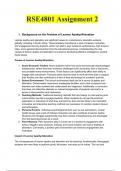RSE4801 Assignment 2
1. Background on the Problem of Learner Apathy/Alienation
Learner apathy and alienation are significant issues in contemporary education systems
globally, including in South Africa. These problems manifest as a lack of interest, motivation,
and engagement among students, which can lead to poor academic performance, high dropout
rates, and a general disconnection from the educational process. Understanding the root
causes of learner apathy and alienation is crucial for developing effective strategies to combat
these issues.
Causes of Learner Apathy/Alienation
1. Socio-Economic Factors: Many students come from socio-economically disadvantaged
backgrounds, where they face numerous challenges such as poverty, lack of resources,
and unstable home environments. These factors can significantly affect their ability to
engage with schoolwork. Financial stress and the need to work part-time jobs to support
their families can also contribute to a lack of time and energy for academic pursuits.
2. School Environment: The school environment itself can be a source of apathy and
alienation. Overcrowded classrooms, inadequate facilities, and a lack of support from
teachers can make students feel undervalued and neglected. Additionally, a curriculum
that does not reflect the interests or cultural backgrounds of students can lead to a
sense of disconnection and irrelevance.
3. Teaching Methods: Traditional teaching methods that rely heavily on rote learning and
memorization can fail to engage students. When students do not see the practical
application or relevance of what they are learning, they are less likely to be interested.
Innovative and interactive teaching methods are necessary to maintain student interest
and enthusiasm.
4. Personal Factors: Individual psychological factors such as low self-esteem, mental
health issues, and a lack of intrinsic motivation can also contribute to learner apathy.
Students who struggle academically may feel a sense of hopelessness and disengage
from the learning process as a result.
5. Peer Influence: Peer dynamics play a crucial role in a student’s engagement with
school. Negative peer pressure, bullying, and social isolation can lead to feelings of
alienation. Conversely, a positive peer environment can enhance engagement and
motivation.
Impact of Learner Apathy/Alienation
The consequences of learner apathy and alienation are far-reaching. Academically, disengaged
students are more likely to perform poorly, fail exams, and drop out of school. This not only
, affects their future opportunities but also contributes to a cycle of poverty and social inequality.
On a personal level, alienated students may suffer from low self-esteem, depression, and a
sense of futility, which can have long-term psychological effects.
Addressing the Problem
Addressing learner apathy and alienation requires a multi-faceted approach. Schools need to
provide a supportive and inclusive environment that caters to the diverse needs of students.
Innovative teaching methods that engage students actively and relate learning to real-life
contexts are essential. Additionally, addressing socio-economic disparities and providing mental
health support can help mitigate some of the external factors contributing to disengagement.
In conclusion, learner apathy and alienation are complex issues with multiple causes and
significant impacts. By understanding these underlying factors and implementing
comprehensive strategies, educators can help re-engage students and foster a more inclusive
and effective learning environment.
2. Problem Statement
Learner apathy and alienation in South African schools have become significant barriers to
academic achievement and personal development. This phenomenon, characterized by a lack
of interest, motivation, and engagement among students, stems from various factors, including
socio-economic challenges, inadequate school environments, traditional teaching methods, and
personal psychological issues. The resulting disengagement leads to poor academic
performance, high dropout rates, and long-term negative impacts on students' futures.
Addressing this issue is crucial for fostering a supportive, inclusive, and effective educational
environment that can help all students reach their full potential.
3. Main Elements of an Interpretative Paradigm
1. Subjectivity and Meaning-Making
The interpretative paradigm is rooted in the belief that reality is socially constructed and
subjective. Researchers within this paradigm focus on understanding the meanings and
interpretations that individuals or groups assign to their experiences. In the context of learner
apathy and alienation, this approach involves exploring how students perceive their educational
experiences and the factors that influence their engagement. By prioritizing students'
perspectives, researchers can gain insights into the nuanced and personal dimensions of
apathy and alienation.
2. Contextual Understanding




